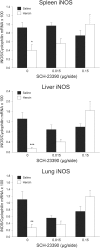Evidence for the nucleus accumbens as a neural substrate of heroin-induced immune alterations
- PMID: 19258519
- PMCID: PMC2683780
- DOI: 10.1124/jpet.108.148627
Evidence for the nucleus accumbens as a neural substrate of heroin-induced immune alterations
Abstract
Administration of opioid drugs such as heroin produces several immunosuppressive effects, including decreases in natural killer (NK) cell activity, lymphocyte proliferative responses, and nitric oxide production. Interestingly, opioids have been shown to alter many immune parameters indirectly by modulating the immunoregulatory actions of the central nervous system. Recently, it has been demonstrated that morphine inhibits NK cell activity through a neural pathway that requires the activation of dopamine D(1) receptors in the nucleus accumbens shell. The present study examined whether the nucleus accumbens also mediates the effects of heroin, a more commonly abused opioid, on several parameters of immune status in Lewis rats. The results showed that bilateral administration of the dopamine D(1) receptor antagonist R-(+)-7-chloro-8-hydroxy-3-methyl-1-phenyl-2,3,4,5-tetrahydro-1H-3-benzazepine hydrochloride (SCH-23390; 0.015 and 0.15 microg/side) into the nucleus accumbens shell blocked decreases in splenic NK activity produced by heroin (3 mg/kg s.c.) but did not attenuate the suppression of splenocyte proliferative responses to concanavalin-A or lipopolysaccharide (LPS). A subsequent experiment was performed to evaluate the effect of D(1) receptor antagonism on LPS-induced expression of inducible nitric-oxide synthase (iNOS) in vivo. These results showed that intra-accumbens SCH-23390 administration prevented heroin-induced reductions of iNOS mRNA expression in spleen, liver, and lung tissues and attenuated the suppression of nitric oxide levels in plasma. Collectively, these findings indicate that nucleus accumbens dopamine D(1) receptors are critically involved in heroin-induced immune alterations.
Figures





Similar articles
-
Suppression of natural killer cell activity by morphine is mediated by the nucleus accumbens shell.J Neuroimmunol. 2006 Apr;173(1-2):3-11. doi: 10.1016/j.jneuroim.2005.11.009. Epub 2005 Dec 20. J Neuroimmunol. 2006. PMID: 16364456
-
Neuropeptide Y Y1 receptors mediate morphine-induced reductions of natural killer cell activity.J Neuroimmunol. 2006 Aug;177(1-2):18-26. doi: 10.1016/j.jneuroim.2006.05.002. J Neuroimmunol. 2006. PMID: 16766046
-
Neuroimmune mechanisms of opioid-mediated conditioned immunomodulation.Brain Behav Immun. 2008 Jan;22(1):89-97. doi: 10.1016/j.bbi.2007.06.009. Epub 2007 Aug 3. Brain Behav Immun. 2008. PMID: 17689049 Free PMC article.
-
Evidence for an involvement of dopamine D1 receptors in the limbic system in the control of immune mechanisms.Neuroimmunomodulation. 1994 May-Jun;1(3):174-80. doi: 10.1159/000097158. Neuroimmunomodulation. 1994. PMID: 7489331
-
Differential effects of blockade of dopamine D1-family receptors in nucleus accumbens core or shell on reinstatement of heroin seeking induced by contextual and discrete cues.J Neurosci. 2007 Nov 14;27(46):12655-63. doi: 10.1523/JNEUROSCI.3926-07.2007. J Neurosci. 2007. PMID: 18003845 Free PMC article.
Cited by
-
Expression of a heroin contextually conditioned immune effect in male rats requires CaMKIIα-expressing neurons in dorsal, but not ventral, subiculum and hippocampal CA1.Brain Behav Immun. 2020 Oct;89:414-422. doi: 10.1016/j.bbi.2020.07.028. Epub 2020 Jul 24. Brain Behav Immun. 2020. PMID: 32717403 Free PMC article.
-
[Asthma and heroin use].Presse Med. 2017 Jul-Aug;46(7-8 Pt 1):660-675. doi: 10.1016/j.lpm.2017.06.002. Epub 2017 Jul 20. Presse Med. 2017. PMID: 28734637 Free PMC article. French.
-
Overview of substance abuse and hepatitis C virus infection and co-infections in India.J Neuroimmune Pharmacol. 2010 Dec;5(4):496-506. doi: 10.1007/s11481-010-9227-6. Epub 2010 Jun 19. J Neuroimmune Pharmacol. 2010. PMID: 20559752 Review.
-
Impact of opioids and mu-opioid receptors on oncologic metastasis.Am J Cancer Res. 2024 Sep 15;14(9):4236-4247. doi: 10.62347/SCLS3277. eCollection 2024. Am J Cancer Res. 2024. PMID: 39417177 Free PMC article. Review.
-
Influence of opioids on immune function in patients with cancer pain: from bench to bedside.Br J Pharmacol. 2018 Jul;175(14):2726-2736. doi: 10.1111/bph.13903. Epub 2017 Jul 23. Br J Pharmacol. 2018. PMID: 28593737 Free PMC article. Review.
References
-
- Deleplanque B, Vitiello S, Le Moal M, and Neveu PJ (1994) Modulation of immune reactivity by unilateral striatal and mesolimbic dopaminergic lesions. Neurosci Lett 166 216-220. - PubMed
-
- Devoino L, Alperina E, Galkina O, and Ilyutchenok R (1997) Involvement of brain dopaminergic structures in neuroimmunomodulation. Int J Neurosci 91 213-228. - PubMed
-
- El Solh AA, Bhora M, Pineda L, and Dhillon R (2006) Nosocomial pneumonia in elderly patients following cardiac surgery. Respir Med 100 729-736. - PubMed
-
- Fecho K, Dykstra LA, and Lysle DT (1993) Evidence for β-adrenergic-receptor involvement in the immunomodulatory effects of morphine. J Pharmacol Exp Ther 265 1079-1087. - PubMed
-
- Fecho K, Maslonek KA, Dykstra LA, and Lysle DT (1996) Evidence for sympathetic and adrenal involvement in the immunomodulatory effects of acute morphine treatment in rats. J Pharmacol Exp Ther 277 633-645. - PubMed
Publication types
MeSH terms
Substances
Grants and funding
LinkOut - more resources
Full Text Sources
Medical
Miscellaneous

